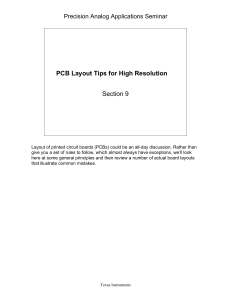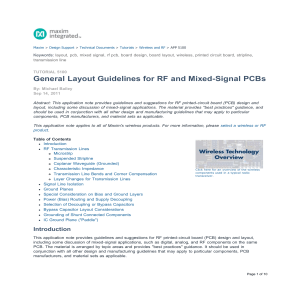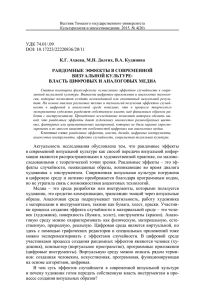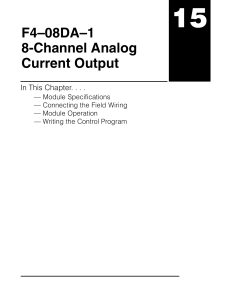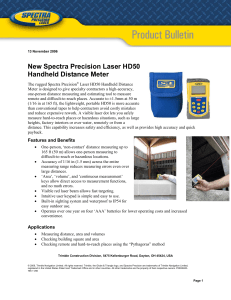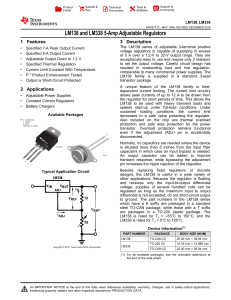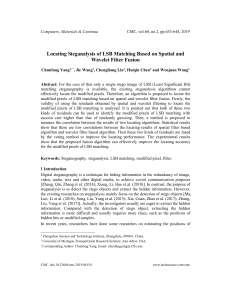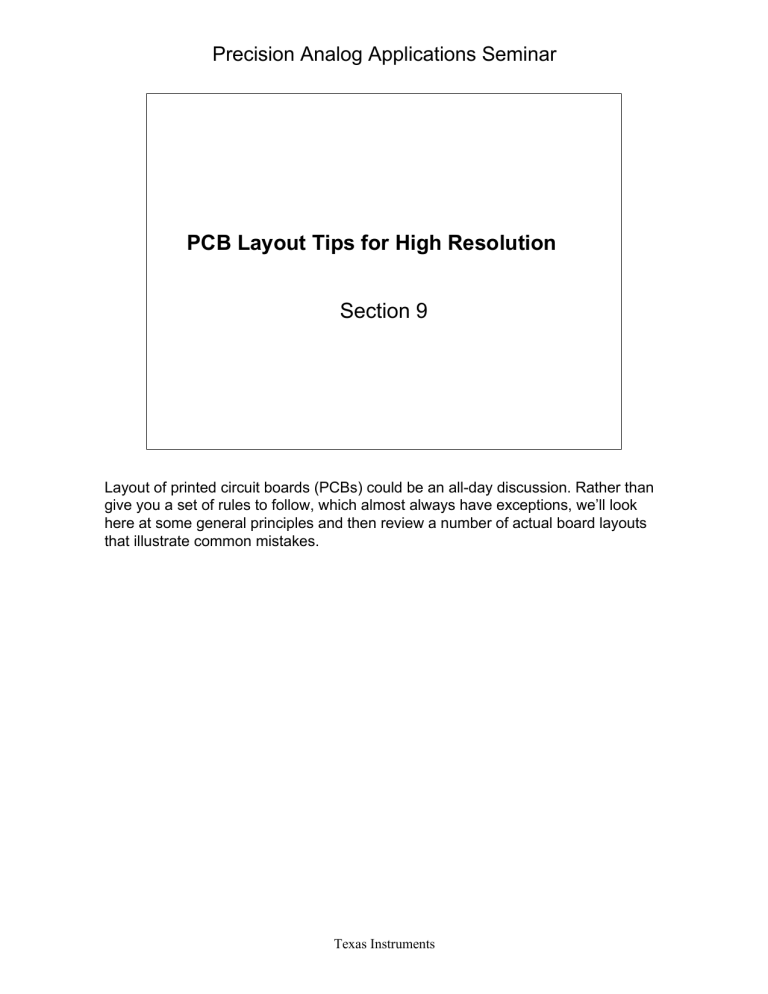
Precision Analog Applications Seminar PCB Layout Tips for High Resolution Section 9 Layout of printed circuit boards (PCBs) could be an all-day discussion. Rather than give you a set of rules to follow, which almost always have exceptions, we’ll look here at some general principles and then review a number of actual board layouts that illustrate common mistakes. Texas Instruments Precision Analog Applications Seminar PCB Layout Tips Outline LSB size Impact on layout decisions Basic PCB Design Principles For High Resolution PCB Layout Reviews Learn from the misfortune of others! Texas Instruments Precision Analog Applications Seminar PCB Layout Tips LSB Size and Its Impact Signal Range Is Critical ±10V is a 20V Range • 16 Bits: 20V/65,536 = 305µV Per LSB • 24 Bits: 20V/16,777,216 = 1,192nV Per LSB ±2.5V is a 5V Range • 16 Bits: 5V/65,536 = 76.3µV Per LSB • 24 Bits: 5V/16,777,216 = 298nV Per LSB ±0.020V is a 0.040V Range • 16 Bits: 0.040v/65,536 = 0.610µV Per LSB • 24 Bits: 0.040V/16,777,216 = 2nV Per LSB Where ±10V gives you an LSB of 305µV, a 5V signal only gives you 76.2µV for a 16-bit LSB. When gain is added into the system, the resolution can sink into the noise. Texas Instruments Precision Analog Applications Seminar PCB Layout Tips High Resolution Measurements 1 inch 1.3µV 10µA 1 inch (7 mil) trace of 1/2 oz copper with 10µA of current => voltage drop of 1.3µV 4 LSBs at 24 bits! You must be careful with the PCB layout for a 12-bit design. For a 16-bit design you have to do everything correctly to achieve that performance; it should be obvious that a 24-bit design will be affected by any errors in the layout. Texas Instruments Precision Analog Applications Seminar PCB Layout Tips Basic PCB Design Principles Separate Analog and Digital Signals AGND and DGND connected at ADC/DAC Provide Good Ground Return Paths High Frequency Bypassing Minimize Inductance Control Thermocouples Differential Signal Measurements The separation of the Analog and Digital section of the PCB keeps noisy digital from the low level analog. However, they must come together at the ADC or DAC. It is important that the Analog Ground and the Digital Ground be connected together at the ADC or DAC. This allows a quick return for the ground currents as the analog and digital portions of the device communicate. Inductance is determined by the size of the loop of current. Providing a path for return currents next to the signal trace will reduce the inductance. That is the advantage of a solid ground plane. If a reasonably solid plane can’t be achieved with two layers, then more layers should be used. Texas Instruments Precision Analog Applications Seminar PCB Layout Tips PCB Layout Process Start with a Split Ground Plane Digital Signals over the Digital Plane Analog Signals over the Analog Plane Then as a Final Step – Remove the Split The Signal Return Currents will flow only Next to the Signal Trace. (A larger path will have increased inductance) Since AGND and DGND are connected at the ADC/DAC and also at the power supply, there is a ground loop created. By having a solid ground plane this can be eliminated. The analog signals will still just flow in the analog portions of the ground plane and the digital signals will only flow in the digital portion of the ground plane. The reason why they will not travel throughout the board, is because a larger path has a larger inductance. The signals will travel through the path of lowest impedance. Texas Instruments Precision Analog Applications Seminar PCB Layout Tips Offset Voltages A temperature differential with any two metals will create a thermocouple This includes PCB feedthroughs A different number of feedthroughs for both sides of a differential signal will create an offset that varies with temperature. Your board design can create additional offset voltages because of the traces and feedthroughs. To minimize offset it is good to route the signal traces differentially next to each other so that they will see the same thermal gradients and the same number of feedthroughs. Texas Instruments Precision Analog Applications Seminar PCB Layout A Rogue’s Gallery We’ll now look at a few examples of circuit layouts that make some common mistakes. Texas Instruments Precision Analog Applications Seminar PCB Layout Tips Layout Review #1 The ground current from U3 was routed to the ground point for the crystal (Y1) capacitors and then to the rest of the ground in the system. This caused a significant effect on the oscillator and made the clock very unstable. Texas Instruments Precision Analog Applications Seminar PCB Layout Tips Layout Review #2 If we position capacitors and components with an order and goal of symmetry, the results could be unnecessary inductance and resistance that are introduced which will reduce the performance of the system. Texas Instruments Precision Analog Applications Seminar PCB Layout Tips Layout Review #3 Here this board is designed with a reasonably solid ground plane and rather than connecting directly with feedthroughs to ground plane, there are large traces to a centralized ground connection point. The extra inductance and resistance, even with wide traces, will reduce the performance of the board compared to feedthroughs (or multiple feedthroughs) placed close to the component’s ground connection. Texas Instruments Precision Analog Applications Seminar PCB Layout Tips Layout Review #4 These top planes seem to be just an area fill for the gaps in the traces. When the plane areas on the top layer are not connected to the ground plane on the bottom, that means that the ground plane on the bottom doesn’t have a continuous path available for current. If these top ground planes were connected to the bottom ground plane, the ground return currents would have a lower inductance path. Texas Instruments Precision Analog Applications Seminar PCB Layout Tips Layout Review #5 Ground Pin Here we see serious splits in the bottom ground plane. A close examination will also show that the traces that are splitting the ground plane are actually also ground signals. Texas Instruments Precision Analog Applications Seminar PCB Layout Tips Layout Review #6-Top As this layer is compared with the next slide, it is evident that some of the traces could have been put on this layer so that the ground layer could have been more solid. Texas Instruments Precision Analog Applications Seminar PCB Layout Tips Layout Review #6 — Bottom This shows the problem of using a digital PCB layout for an analog board. It simplifies the routing for most of the traces on each layer to go one direction, but that might lead to inefficiencies in the ground return currents and an unnecessary increase in inductance. Remember, inductance is defined by the size of the loop for the current. Texas Instruments Precision Analog Applications Seminar PCB Layout Tips Layout Review #7 There is a good separation between the analog and digital sections, but the AGND and DGND should be connected together at the ADC. Texas Instruments Precision Analog Applications Seminar PCB Layout Tips Forgotten Feedthrough The goal was to place the resistor to protect the reset pin. The close placement of the resistor didn’t solve the problem. However the feedthrough was to an external connector that defeated the purpose of the resistor. Texas Instruments Precision Analog Applications Seminar PCB Layout Tips Layout Review #8 The Analog and Digital sections are nicely separated. The AGND and DGND are connected with a wide connection right at the MSC1210. But the ground plane sometimes has narrow channels for current which will increase inductance and noise. The return currents for the digital signals will want to travel under the horizontal traces, but the channels in the ground plane are generally vertical. Texas Instruments Precision Analog Applications Seminar PCB Layout Tips Layout Review #9 — Before Analog and Digital sections separated with ground planes on both the bottom and the top. But the bottom ground plane is seriously split so that the ground return currents can’t flow close to the source signal wires. Texas Instruments Precision Analog Applications Seminar PCB Layout Tips Cleaned Up Layout #9 — After A few simple changes in the routing were able to provide a much better ground return path. Larger continuous areas of ground plane translate into short return current paths and lower inductance. Texas Instruments Precision Analog Applications Seminar PCB Layout Tips Summary LSB size Higher resolution systems reveal PCB layout errors more clearly! Basic PCB Design Principles Separate analog and digital signals Establish good grounding Minimize inductance Control thermocouples PCB Layout Reviews Learn from your mistakes! Texas Instruments Precision Analog Applications Seminar Texas Instruments
